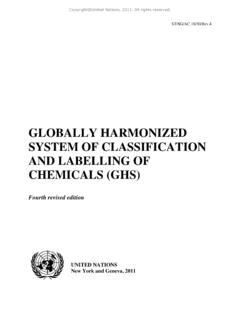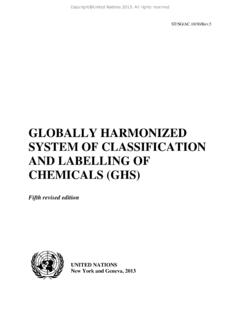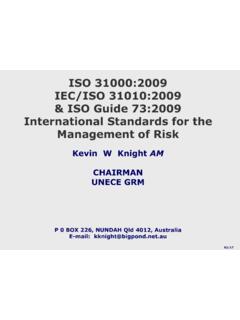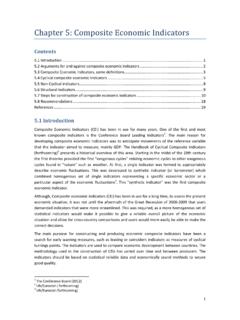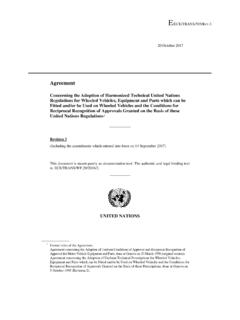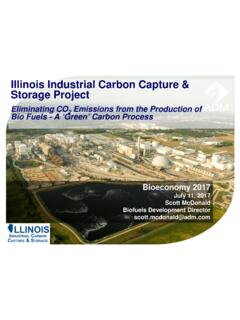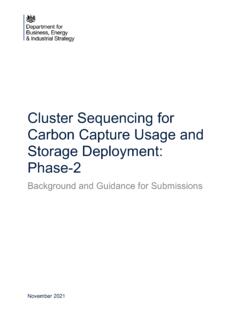Transcription of TECHNOLOGY BRIEF - UNECE
1 carbon capture , USE AND storage (CCUS) TECHNOLOGY BRIEFAll rights reserved worldwide Requests to reproduce excerpts or to photocopy should be addressed to the Copyright Clearance Center at All other queries on rights and licenses, including subsidiary rights, should be addressed to: United Nations Publications, 405 East 42nd St, S-09FW001, New York, NY 10017, United States of America. Email: website: findings, interpretations and conclusions expressed herein are those of the author(s) and do not necessarily reflect the views of the United Nations or its officials or member States. The designation employed and the presentation of material on any map in this work do not imply the expression of any opinion whatsoever on the part of the United Nations concerning the legal status of any country, territory, city or area, or of its authorities, or concerning the delimitation of its frontiers or boundaries.
2 Mention of any firm, licensed process or commercial products does not imply endorsement by the United Nations. This publication is issued in English and Russian. United Nations publication issued by the United Nations Economic Commission for Europe. carbon capture , Use And storage (CCUS) ACKNOWLEDGMENTSThis TECHNOLOGY BRIEF is one of the outcomes of the project called Enhancing understanding of the implications and opportunities of moving to carbon neutrality in the UNECE region across the power and energy intensive industries by 2050 . The project was managed by Iva Brkic with support from Walker Darke and Yezi Lyu and under strategic guidance and advice of Stefanie Held, Chief of the Sustainable Energy Section and Scott Foster, Director of Sustainable Energy Division.
3 The project was run under the auspices of the Group of Experts on Cleaner Energy Systems with continuous support from countries and the whole UNECE Sustainable Energy Programme. This BRIEF was prepared by the UNECE Task Force on carbon Neutrality and a dedicated team of high-level interna-tional experts who offered quality control, advice, and validation of findings. The project team greatly thanks to Carolina Coll, Jon Gibbins, Sigurd Heiberg, Wolfgang Heidug, Denis Hicks, Alexander Krowka, Andrew Minchener and Grant Wach for their expertise and continuous support. The project team and the authors wish to thank Shuyue Li for providing visual communication and design services for this TECHNOLOGY BRIEF .
4 Cover photo: Marcin Jozwiak, PexelsDisclaimer The document does not necessarily reflect the position of reviewers and partners listed above who provided their comments and helped to develop this BRIEF CONTENTSA cknowledgements .. iiiKey Takeaways .. 1 Capacity Building .. 21. Introduction .. 42. Engineered Technologies for capture .. 6 CCUS from Point Sources .. 6 BECCS and DACCS .. 73. Technologies for storage .. 8 Aquifers for Sequestration of CO2 .. 8 Enhanced Oil Recovery (EOR) .. 94. carbon storage Readiness .. 105. Solutions for carbon Utilization .. 116. Comparative Analysis of CCUS Technologies .. 13 CCUS Technologies Cost Curve and carbon capture Potential.
5 13 How Can Policy Makers Support the Private Sector to Act on Climate Change? .. 14 Comparative Analysis - CCUS Readiness Level .. 15 Comparative Analysis - CCUS Readiness Level Across UNECE Region .. 16 Annex I UNFC as Means to Verify CCUS Potential with International Cooperation .. 17 Annex II List of CCUS Projects Across UNECE Region .. 18 Abbreviations .. 25 References .. 261 TECHNOLOGY BRIEF KEY TAKEAWAYS Access to energy has been recognized by the United Nations Economic Commission for Europe ( UNECE ) as critical for assuring quality of life. At present, 80% of the energy usage in the UNECE region is fossil-fuel based. Many coun-tries are reliant on non-renewable sources for their energy security and economic well-being, yet there is a growing global urgency to transition to a more sustainable energy future with increased dependence on renewable energy sources, improved energy efficiency, and reduced global carbon emissions.
6 carbon capture , use and storage (CCUS) TECHNOLOGY is an essential step towards mitigating climate change. CCUS allows UNECE member States to establish a pathway to carbon neutrality and stay within their emission targets. Political agreement is required for long-term engagement and societal commitment, recognizing the scale and cost of the industry that needs to develop in a very short time billions of tonnes of CO2 and trillions of US$.We are running out of time Structural change will be much deeper than most people expect and needs to start now. The greater the delay, the greater the change good practice is neededInclusive multi-stakeholder initiatives can bestrength-ened by public-private partnerships.
7 Government and industry support is key. Industry commits to wide ranging greeningThe private sector should lead the structural change through design, material efficiency, sustainable energy TECHNOLOGY interplay and requires government up favorable conditionsLegal, financial and regulatory frameworks must be developed with infrastructure and banking institutions. Government support can provide initial momentum that will get industry together beyond borders A sub-regional approach to share knowledge and best practices is needed to improve cost efficiencies for large infrastructure projects. Act now, CCUS unlocks full decarbonization of energy sector Countries need to include CCUS in long-term strategies and commence retrofitting existing infrastructure.
8 1 TECHNOLOGY BRIEF 2 carbon capture , Use And storage (CCUS) CAPACITY BUILDINGThe UNECE has taken action to support countries in implementing CCUS technologies and attaining carbon neutrality. This action has focused on three core aims. These are to:Raise awareness Recognize CCUS as an essential climate mitigation option and consider it when developing national TECHNOLOGY Develop and integrate policies to allow full use of CCUS technologies for energy and intensive project Create funding mechanism for CCUS and direct investments towards modernization of energy infrastructure. High level roundtables, policy dialogues and development of financial guidelines continue to raise awareness with stakeholders about the potential of CCUS technologies to attain carbon neutrality in the UNECE convened a Task Force on carbon Neutrality under the auspices of the Group of Experts on Cleaner Electricity Systems to understand the potential of CCUS technologies across the UNECE work has been conducted by the Task Force on carbon Neutrality as part of implementation of the extrabudgetary project on Enhancing the understanding of the implications and opportunities of moving to carbon neutrality in the UNECE region across
9 The power and energy intensive industries by 2050 . carbon utilization can unlock the commerciality of CCUS projects for the industrial, steel, cement and chemical sectors. CO captured can be used as a feedstock to produce a range of products, such as concrete, methanol, ethanol, carbonates, plastics etc. AwarenessRecognise CCUS as a viable climate mitigation option and consider it when developing national and integrate policies to allow full commercialisation of CCUS a funding mechanism for CCUS and direct investments towards modernization of energy SOURCE IDENTIFICATIONCO injectionEnhanced Oil Recovery (EOR)Enhanced Oil Recovery (EOR)Aquifers for Sequestration of COSolutions for carbon UtilizationPoint Sources of CO in IndustryOilCCUS is essential to unlock the full potential of decarbonization and attain carbon neutralityEOR is a family of techniques that increases the recovery of oil and gas while storing CO.
10 Dependent on operational choices, the volume of CO stored could exceed the CO content of the produced are geological formations containing brine in porous rock at depths over 1km. CO can be pumped down into the rock for sequestration. Net negative emissions technologies are key to reach net-zero and then net negative emissions. In BECCS, CO is taken out of the atmosphere by vegetation, then recovered from the combustion products when the biomass is burnt. In DACCS, CO is captured directly from the from industries (cement, steel), hydrogen production from fossil fuels, or power generation is captured before it reaches the atmosphere and is then compressed and injected into porous rock oilrecoveryPURIFICATION & COMPRESSION3 Compressed CO transport via pipeline or shipTRANSPORT4 UTILIZATION6CO capture & SEPARATION2 CaprockCO injectionBiomass or fuelAmbient airFlue gasChemical separationBiomass Energy with carbon capture and storage (BECCS)Direct Air carbon capture and storage (DACCS)


